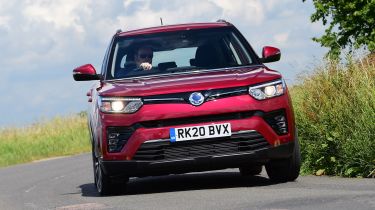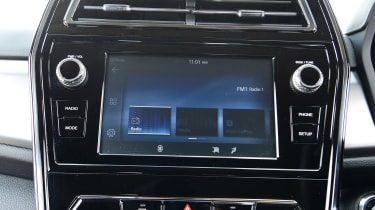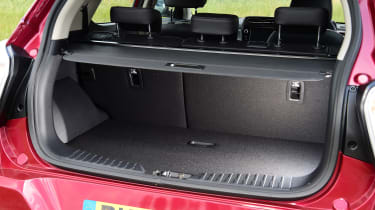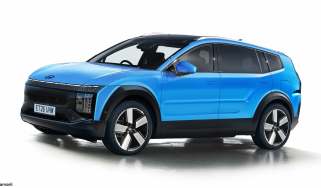SsangYong Tivoli review
If you want something different from your small crossover, the SsangYong Tivoli is close to matching its mainstream rivals in most areas
If you're in the market for a workhorse SUV on a budget, then you're probably familiar with SsangYong. The Korean maker has been a bit part player in the UK car market for many years, with a range of durable and well equipped SUVs, pickups and MPVs that offer good value, even if they are a little rough around the edges. However, the Tivoli compact crossover attempts to push SsangYong sales to a new level. It slots into the hard-fought small crossover market, where a growing glut of supermini-sized cars with SUV styling are battling for sales.
Not only is the Tivoli the smallest SsangYong yet, the firm has taken great effort to make it attractive to buyers wanting some style with their purchase. As a result, the Tivoli uses a unique platform and is powered by a choice of two petrol engines and a diesel option. Following an update in 2020, the Tivoli is better than ever.
There are two body styles: the regular five-door model and the larger Tivoli XLV, which features extra boot space thanks to an extended tail section. The XLV commands a price premium over the standard Tivoli, although it only comes in top-spec Ultimate trim. All versions come with a choice of a six-speed manual or automatic gearbox. The four-wheel drive versions have been discontinued.
More reviews
Car group tests
- Dacia Duster vs Suzuki Ignis vs SsangYong Tivoli
- Fiesta Active vs C3 Aircross vs Tivoli
- SsangYong Tivoli XLV vs Dacia Duster vs Suzuki Vitara
In-depth reviews
Long-term tests
Road tests
- New SsangYong Tivoli 2020 review
- SsangYong Tivoli XLV manual 2016 review
- New SsangYong Tivoli XLV 2016 review
Used car tests
SsangYong hopes that this broad scope of engine, drivetrain and body choice, coupled with a unique design, generous spec and seven-year/150,000-mile warranty, will attract buyers. And all of this is offered for a starting price of around £14,000.
The Tivoli received a facelift in 2020, intended to keep the budget SUV competitive against new rivals. Changes included a styling refresh, a new dashboard and eight-inch infotainment system with Apple CarPlay and Android Auto, while some models benefit from a 10.25-inch digital instrument panel. There are three trim levels: EX, Ventura and Ultimate.
Key rivals for the Tivoli are the Skoda Kamiq, Peugeot 2008, Nissan Juke, Renault Captur and Ford EcoSport, while the Dacia Duster is a cheaper budget alternative that's also available with locking four-wheel drive.
The Tivoli offers good value, but it's a very capable car that stands up to comparison with the class leaders. Build quality is a bit patchy in places, but it handles reasonably well, offers decent cabin space, and looks good. Buyers choosing the Tivoli will primarily be motivated by value for money, but this is one SsangYong that should be surprisingly good to own.
You can put aside your reservations about the SsangYong badge, because the Tivoli is a thoroughly capable small crossover for the money. It’s not the most stylish inside or out, and it won’t win awards for ride comfort or refinement, but you get a lot of space and kit for little financial outlay.
The latter two points are especially true of the Tivoli XLV, but it’s more expensive, and we'd go for the two-wheel-drive version to save some money. The standard Tivoli is decent to drive, while with the diesel engine and is by far the best on-road car SsangYong has built yet.
Engines, performance and drive
Traditionally the driving experience was never a SsangYong strong point, with most of the firm's models engineered for durability and off-road toughness over on-road refinement. Comfort and ride quality, rather than outright performance, tend to be top of the list for crossover buyers, and the Tivoli delivers just enough refinement to be close to the class standard in terms of ride and handling.
There are no fancy adaptive dampers or sport suspension options here: the Tivoli features McPherson strut suspension up front and a Torsen beam set-up at the rear.
At speed on the motorway or on smooth surfaces the car is relatively composed, but once you turn off on to twistier, more undulating roads, the Tivoli loses a little of its poise. Hitting a bump mid-corner will knock the chassis off line, sending a thump through the structure as the wheel rebounds with a noticeable lack of control.
It’s not the most agile crossover and it doesn’t have much grip, but the light steering at least means it’s not taxing to drive. The Tivoli features three steering modes – Comfort, Normal and Sport – but it’s best left in Normal, as Sport feels artificial and Comfort is a little too light.
The extended rear bodywork of the XLV doesn't affect the car's handling, so it drives much like the standard Tivoli. Low speed manoeuvrability is good too, with one of the tightest turning circles in the class.
The biggest fly in the Tivoli ointment is the ride. Although the suspension soaks up the biggest bumps well, the car never feels truly settled. The background jiggling as the car moves over the road surface can be intrusive, and swapping from 18-inch to smaller 16-inch wheels does little to rectify it. It settles down with extra weight on board, but it’s still way off the comfort you’ll get from a Renault Captur or Suzuki Vitara, which is a shame. At least wind and road noise aren’t too intrusive.
Engines, 0-60 acceleration and top speed
The Tivoli gets a simple engine range: a 1.6-litre diesel and a choice of 1.2-litre three-cylinder and 1.5-litre four-cylinder petrols.
The updated 1.6-litre diesel delivers decent performance, but rev the engine hard and its lack of refinement shows. If you’re more careful with the throttle and surf along on the 342Nm wave of torque from 1,500rpm, progress is more relaxing. In-gear acceleration is acceptable, but if you do have to work the box harder, the shift action isn’t the sweetest. It can sometimes obstruct you selecting gears – especially when slowing for junctions and going back into first.
New petrol engines were introduced as part of the 2020 facelift, replacing the old 1.6-litre petrol unit. The base engine is a 1.2-litre turbocharged three-cylinder petrol producing 126bhp and 230Nm of torque. Those wanting more power should opt for the 1.5-litre turbocharged four-cylinder engine, which produces 161bhp and 280Nm of torque.
SsangYong fits a six-speed manual gearbox as standard on the Tivoli. The shift is slightly long-winded but it's positive and with a nice weight to it. A longer sixth gear would be useful to keep the revs down on the motorway. The optional automatic is fairly smooth, but shifts can be ponderous if you demand speed and it blunts both performance and efficiency.
MPG, CO2 and running costs
The 1.6-litre diesel pumps out CO2 emissions of 146g/km while managing a claimed combined economy figure of 50.4mpg. Fuel economy drops to 47.1mpg in the automatic version, while CO2 emissions increase to 158g/km.
The petrol engines make more sense for drivers who spend most of their time in the city. You should see around 40mpg from both the 1.2-litre and 1.5-litre units, although fitting an automatic transmission to the 1.5-litre petrol engine sees the economy drop to 36.7mpg.
These figures are passable, but the Tivoli lags behind rivals powered by efficient 1.0-litre turbocharged petrol engines. It also suffers from an absence of electrified options.
Insurance groups
Despite the Tivoli’s bargain-basement intentions, it isn’t quite as cheap to insure as you might expect. The petrol starts at group 14, while the range-topping Ultimate diesel slots into group 22.
Depreciation
Depreciation could be the biggest reason why buyers flock to better-known brands than SsangYong. Traditionally, small-time firms like SsangYong struggle to maintain residual values, but offering a seven-year warranty across its range helps here. The Tivoli’s low price also gives it an advantage as it stands to hold between 39 and 43 per cent of its value after three years. That’s broadly in line with most rivals, and shows how popular small crossovers are nowadays.
Interior, design and technology
While the Tivoli still retains some of the characteristics of SsangYong’s larger SUVs, it’s more of an urban crossover than a full-on 4x4, and this is reflected in the car’s looks.
Visually, the Tivoli gets a wide, purposeful stance with a flat roofline linked to the body by a thick C-pillar. The A and B pillars are blacked-out to achieve that fashionable ‘floating roof’ effect. At the back, the curvy rear window and sloping lights give it a modern look, but some will find it generic and slightly over-styled -especially in the larger and longer XLV model.
Rather than offering a range of options, SsangYong loads the Tivoli with a long list of standard equipment. The original entry-level SE model has been deleted, which means the old mid-range EX trim is now the starting point. The Ventura and Ultimate models come with the kind of equipment that would be optional on rival models.
The XLV inherits the regular Tivoli’s design, but while the bluff front looks similar, some tweaks to the bumper – including the dark grey insert around the lower light clusters – add presence. The big, square wheelarches give the SsangYong a solid look and strong shoulderline, but the way these creases integrate into the longer body aren’t quite as elegant as on its smaller sibling. Both cars share an identical wheelbase, which explains why the larger rear overhang on the XLV makes it look a little awkward from some angles.
The large rear lights are a simple design, and with the flat tailgate the rear isn’t quite as striking as the front. However, apart from a few minor details, the SsangYong’s looks have remained fairly faithful to the design concept that was unveiled in 2015. The 2020 facelift included new three-piece fog lights, a larger grille with faux chrome detailing, and new tail light signatures.
If anything, the Tivoli interior is an even greater revelation than the outside. The design can stand its ground next to mainstream players with a smart eight-inch central screen and, on the Ultimate model, a 10.25-inch digital instrument cluster. There's a premium focus to the interior that's obvious once you climb aboard.
Leather seats are standard on Ultimate models. Go for Dandy Blue or Space Black metallic paint, and you get grey leather as standard, while other colours get black leather. Touch points such as the indicators and leather-wrapped steering wheel feel upmarket. However, there are solid plastics elsewhere – the dash is acceptable, but the buttons and knobs on the centre console feel cheap. The layout means it can be difficult to find the one you want at a glance, too.
It’s not as stylish inside as a Peugeot 2008, and some of the materials aren’t up to the standards of the class leaders, but SsangYong is now closer to mainstream rivals than ever before. Our only complaint with the design is details such as the fiddly climate control buttons and a lack of reach adjustment on the wheel on the EX model.
Three generously equipped trim levels are offered. The EX starts from under £14,000 and gets 16-inch steel wheels, manual air conditioning, cruise control, keyless entry, three-mode steering, DAB digital radio, Bluetooth, steering wheel-mounted audio controls and tinted glass.
Ventura adds 16-inch alloy wheels, triple LED front fog lights, rear parking sensors, eight-inch touchscreen infotainment system, Apple CarPlay, Android Auto, rear-view camera, keyless start, automatic headlights, rain-sensing wipers, height and reach adjustable steering wheel, luggage cover and cosmetic upgrades.
The flagship Ultimate trim features 18-inch diamond-cut alloy wheels, rear spoiler with LED brake light, nine-inch HD touchscreen, dual-zone climate control and 10.25-inch digital instrument cluster.
Sat-nav, stereo and infotainment
While base models make do with a basic radio, Ventura trim (from under £17,000) brings the eight-inch touchscreen and a reversing camera. But you’ll need to step up to Ultimate for the full sat-nav features.
The screen itself is surprisingly user-friendly and slick; in fact we’d go as far as saying it’s a better system than the one found in some modern Land Rovers. It responds well to finger inputs, and while it’s not the most feature-packed it does enough for most needs.
The sat-nav’s graphics are a bit dated and not the easiest to follow, but the system works well enough. Bluetooth pairing seems to work perfectly well, too. The six-speaker multimedia system sounds adequate, while Apple CarPlay and Android Auto are fitted to all except the EX model.
Practicality, comfort and boot space
The compact crossover class is a market sector where practicality plays second-fiddle to style, but the Tivoli is up with the very best cars of its type in terms of cabin and boot space. It’s a pleasant surprise, especially given how poor cars like the Nissan Juke are for rear-seat accommodation. The Tivoli might be SsangYong’s smallest car, but it still packs more in than you might expect.
The elevated ride height that defines the crossover class helps make entry and exit straightforward. All four doors open wide and once you’re in, the seating is firm but comfortable. SsangYong offers optional heated rear seats, which have two settings – off and very hot. You have been warned.
Storage space in the cabin is good, with deep pockets in the doors, bungee-style map pockets on the seat backs and plenty of small cubbies. Cabin space is also amongst the best in this price range, and two adults (three at a push) can get comfortable in the back. It’s only really in terms of quality of materials where the Tivoli's cabin gives anything away to rivals.
The only downside for die-hard SsangYong fans is that, by chasing a more civilised feel, it has lost its go-anywhere useability and large towing capacity.
Size
The Tivoli is firmly in the small crossover territory, but it still offers a lot of metal for your money. It’s 4.2-metres long and around 50mm longer than a Nissan Juke, which pays dividends in terms of passenger and boot space. Its square shape also allows the maximum cabin space for the minimum exterior size, unlike the curvy Nissan.
Leg room, head room & passenger space
It's not much bigger than many superminis in terms of its footprint, but a six-footer can sit relatively comfortably behind another adult of similar height, making this one of the best cars in the class for buyers intending to regularly use their rear seats. Headroom is also good thanks to the boxy shape while the seats are comfortable, especially the leather items on EX spec and above.
Boot
Further back there’s a 423-litre boot that compares favourably with the Nissan Juke (354 litres) and the Peugeot 2008 (350 litres) but less so with the Renault Captur (455 litres). SsangYong says it’ll swallow three golf bags. Given the passenger space on offer, that’s still very competitive.
With a 547-litre luggage area (or 720 litres without the movable boot floor), the Tivoli XLV (below) offers even more space, but these figures are calculated using all the space to the roofline. The 60:40-split rear seats recline by up to 32.5 degrees, offering more comfort for rear passengers. Legroom in the back is fine, and the high roof means even tall adults won’t feel cramped in the XLV.
Reliability and Safety
The Tivoli isn’t yet popular enough to feature in our Driver Power customer satisfaction survey, but that shouldn’t worry you. The brand has a reputation for building solid and durable off-roaders, and while the Tivoli is relatively young, it’s not groundbreaking by any means.
Euro NCAP awarded the Tivoli a creditable four-star safety rating when it was tested in 2016. All models get multiple airbags, active rollover protection, forward collision warning, autonomous emergency braking, lane departure warning, lane keeping assist, traffic sign recognition, driver attention alert and hill descent control. Only the EX model lacks a driver’s knee airbag.
Warranty
Should anything go wrong, there’s the added peace of mind that comes with the brand’s seven-year, 150,000-mile warranty, Not only does this guarantee cover all the usual mechanical parts, SsangYong also provides a year or 12,500 miles’ protection for the clutch and brake pads, which is a unique offer in the new car market.
Servicing
A petrol Tivoli requires attention every 10,000 miles or 12 months, while the diesel can go to 12,500 miles. It compares well with cars like the Nissan Juke. Servicing costs shouldn’t be too pricey, but there’s not a huge amount of SsangYong dealers to choose from.


















